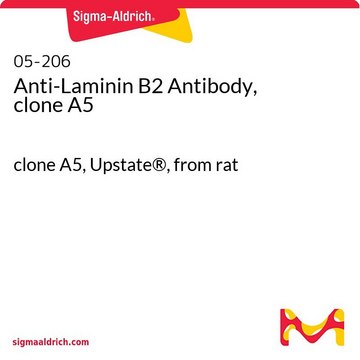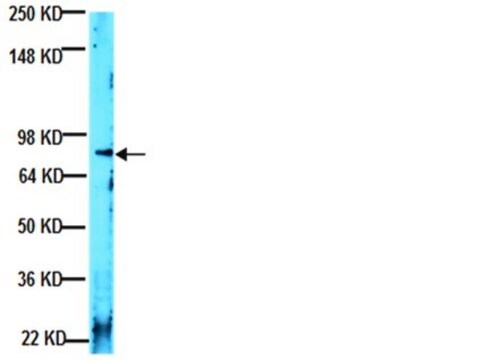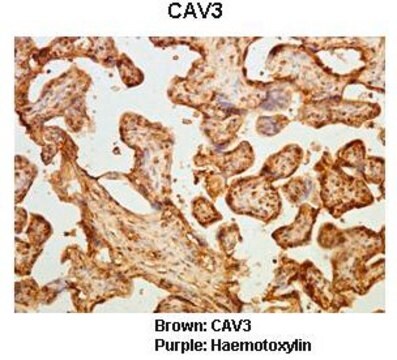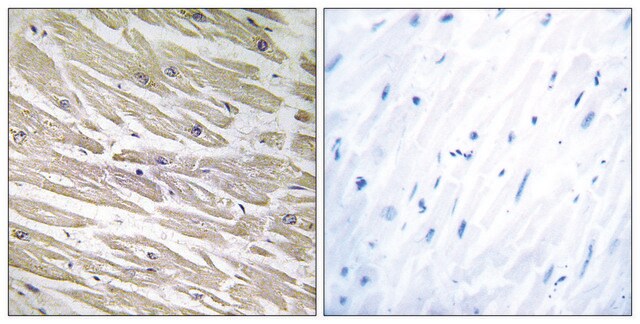L0663
Anti-Laminin-2 (α-2 Chain) antibody, Rat monoclonal
clone 4H8-2, purified from hybridoma cell culture
Sinonimo/i:
Anti-Merosin
About This Item
Prodotti consigliati
Origine biologica
rat
Livello qualitativo
Coniugato
unconjugated
Forma dell’anticorpo
purified immunoglobulin
Tipo di anticorpo
primary antibodies
Clone
4H8-2, monoclonal
Forma fisica
buffered aqueous solution
PM
antigen ~400 kDa (denatured)
Reattività contro le specie
human, mouse
Confezionamento
antibody small pack of 25 μL
Concentrazione
~2 mg/mL
tecniche
immunocytochemistry: suitable
immunohistochemistry (frozen sections): suitable
immunoprecipitation (IP): suitable
indirect ELISA: suitable
indirect immunofluorescence: 4-8 μg/mL using acetone-fixed frozen sections of human tongue
microarray: suitable
western blot: suitable
Isotipo
IgG1
N° accesso UniProt
Condizioni di spedizione
dry ice
Temperatura di conservazione
−20°C
modifica post-traduzionali bersaglio
unmodified
Informazioni sul gene
human ... LAMA2(3908)
mouse ... Lama2(16773)
Descrizione generale
Laminin, the most abundant structural and biologically active component in basement membrane, is a complex extracellular glycoprotein of 700-900 kDa that plays an important role in many aspects of the cell biology. It is composed of one α chain (approx. 400 kDa, previously called A chain) one β chain (215 kDa, B1) and one γ chain (205 kDa, B2), held together by disulfide bonds.
Anti-Laminin-2 (α-2 Chain) antibody, Rat monoclonal (rat IgG1 isotype) is derived from the 4H8-2 hybridoma produced by the fusion of rat myeloma cells and splenocytes from a Lewis rat immunized with mouse heart laminin-2.1 The antibody is purified from the culture supernatant of hybridoma cells grown in a bioreactor. Anti-Laminin-2 (α-2 Chain) antibody, Rat monoclonal reacts specifically with mouse1 and human2, laminin-2. The epitope recognized by the antibody resides in the N-terminal portion of the α2 chain of laminin.
Specificità
Immunogeno
Applicazioni
Azioni biochim/fisiol
Stato fisico
Nota sulla preparazione
Stoccaggio e stabilità
Esclusione di responsabilità
Non trovi il prodotto giusto?
Prova il nostro Motore di ricerca dei prodotti.
Raccomandato
Codice della classe di stoccaggio
12 - Non Combustible Liquids
Classe di pericolosità dell'acqua (WGK)
nwg
Punto d’infiammabilità (°F)
Not applicable
Punto d’infiammabilità (°C)
Not applicable
Certificati d'analisi (COA)
Cerca il Certificati d'analisi (COA) digitando il numero di lotto/batch corrispondente. I numeri di lotto o di batch sono stampati sull'etichetta dei prodotti dopo la parola ‘Lotto’ o ‘Batch’.
Possiedi già questo prodotto?
I documenti relativi ai prodotti acquistati recentemente sono disponibili nell’Archivio dei documenti.
I clienti hanno visto anche
Il team dei nostri ricercatori vanta grande esperienza in tutte le aree della ricerca quali Life Science, scienza dei materiali, sintesi chimica, cromatografia, discipline analitiche, ecc..
Contatta l'Assistenza Tecnica.
















